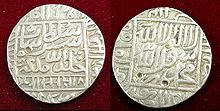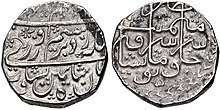Rupee
Rupee (UK: /ˌruːˈpiː/, US: /ˈruːpiː/)[1][2] is the common name for the currencies of India, Mauritius, Nepal, Pakistan, Seychelles, and Sri Lanka, and of former currencies of Afghanistan, Bahrain, Kuwait, Oman, the United Arab Emirates (as the Gulf rupee), British East Africa, Burma, German East Africa (as Rupie/Rupien), and Tibet.The history of the rupee traces back to Ancient India circa 3rd century BC.Ancient India was one of the earliest issuers of coins in the world,[4] along with the Lydian staters, several other Middle Eastern coinages and the Chinese wen.In the intermediate times there was no fixed monetary system as reported by the Da Tang Xi Yu Ji.[10] During his reign from 1538/1540 to 1545, Sher Shah Suri of the Sur Empire set up a new civic and military administration and issued a coin of silver, weighing 178 grains, which was also termed the Rupiya.[14][15] The European powers started minting coinage as early as mid-17th century, under patronage of Mughal Empire.It was only in AD 1717 that the British obtained permission from the Emperor Farrukh Siyar to coin Mughal money at the Bombay mint.The compulsion of the Second World War led to experiments in coinage where the standard rupee was replaced by the "Quaternary Silver Alloy".The 1955 Indian Coinage (Amendment) Act, that came into force with effect from 1 April 1957, introduced a "Decimal series".With high inflation in the sixties, small denomination coins which were made of bronze, nickel-brass, cupro-nickel, and aluminium-bronze were gradually minted in aluminium only.The usage of the rupee in East Africa extended from Somaliland in the north to as far south as Natal.In 1920 in British East Africa, the opportunity was then taken to introduce a new florin coin, hence bringing the currency into line with sterling.In most parts of India, the rupee is known as rupaya, rupaye, or one of several other terms derived from the Sanskrit rūpya, meaning silver.In the Bengali and Assamese languages, spoken in Assam, Tripura, and West Bengal, the rupee is known as a taka, and is written as such on Indian banknotes.Large denominations of rupees are traditionally counted in lakhs, crores, arabs, kharabs, nils, padmas, shankhs, udpadhas, and anks.The precomposed character ₨ is a currency sign used to represent the monetary unit of account in Pakistan, Sri Lanka, Nepal, Mauritius, Seychelles, and formerly in India.Punjabi The history of the rupees can be traced back to Ancient India around the 6th century BC[citation needed].[22] Valuation of the rupee based on its silver content had severe consequences in the 19th century, when the strongest economies in the world were on the gold standard.
India , Indonesia , Maldives , Mauritius , Nepal , Pakistan , Seychelles , Sri Lanka
Orange : Countries where a foreign country's rupee is legal tender
Indian rupee : Bhutan
Indonesian rupiah : East Timor








Rupee (disambiguation)IndonesiaMaldivesMauritiusPakistanSeychellesSri Lankalegal tenderIndian rupeeBhutanIndonesian rupiahEast TimorcurrenciesAfghanistanBahrainKuwaitUnited Arab EmiratesGulf rupeeBritish East AfricaGerman East AfricaRupie/RupienrupiahrufiyaacognatesPakistani rupeeNepalese rupeesukaasMauritianSeychelloisSri Lankan rupeesHindustaniSanskritHistory of the rupeeMaurya EmpireSkandaguptaGupta EmpireWestern SatrapspeacockSher Shah SuriFrench East India CompanyMuhammad ShahPondicherryZaman Shah DurraniPeshawarGovernment of IndiaAncient IndiastatersChinese wensilver coinArthashastraChanakyaMaurya emperorChandragupta MauryaSur Empiregrainsgold coinsMughal EmpireMughal Emperor AkbarBengal PresidencyShah Alam IIminted in CalcuttaMughalMadrasFarrukh SiyarBombayWilliam IVPersianQueen Victoriagold silver ratioGeorge VFirst World WarSecond World WarRepublic of IndiaaluminiumbronzeArabiaMesopotamiaSomalilandBritish East Africa CompanysterlingflorinEast African shillingsBritish IndiaQatar-Dubai riyalStraits SettlementsBritish East India CompanySpanish dollar.917 finenumbersDecimalisationWest PakistanEast PakistanBangladeshTripuraOdishaReserve Bank of IndiaState Bank of PakistancroreskharabspadmasshankhsRupee signCurrency signIndian rupee signprecomposed charactermonetary unitLatin charactermain articlecodepointsCJK Compatibilityligaturescombining diacriticLatin scriptgraphemeSinhalaTeluguPunjabiGurmukhiShahmukhiGujaratiKannadaMalayalamtroy ouncegold standardgold exchange standardpound sterling